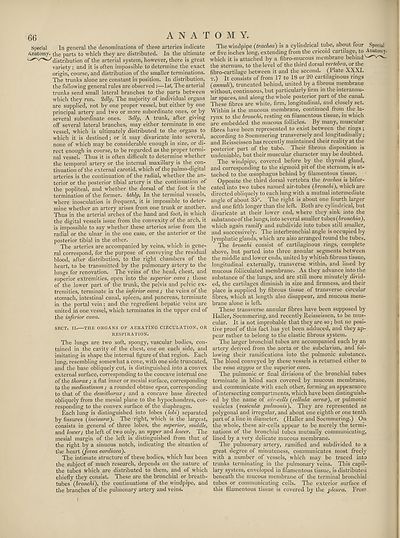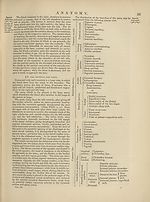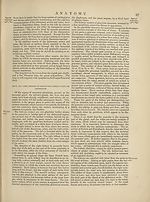Encyclopaedia Britannica > Volume 3, Anatomy-Astronomy
(74) Page 66
Download files
Complete book:
Individual page:
Thumbnail gallery: Grid view | List view

66 A N A T
Special In general the denominations of these arteries indicate
Anatomy, the parts to which they are distributed. In the ultimate
distribution of the arterial system, however, there is great
variety; and it is often impossible to determine the exact
origin, course, and distribution of the smaller terminations.
The trunks alone are constant in position. In distribution,
the following general rules are observed:—ls£, The arterial
trunks send small lateral branches to the parts between
which they run. 2dly, The majority of individual organs
are supplied, not by one proper vessel, but either by one
principal artery and two or more subordinate ones, or by
several subordinate ones. 3dh/, A trunk, after giving
off several lateral branches, may either terminate in one
vessel, which is ultimately distributed to the organs to
which it is destined; or it may divaricate into several,
none of which may be considerable enough in size, or di¬
rect enough in course, to be regarded as the proper termi¬
nal vessel. Thus it is often difficult to determine whether
the temporal artery or the internal maxillary is the con¬
tinuation of the external carotid, which of the palmo-digital
arteries is the continuation of the radial, whether the an¬
terior or the posterior tibial artery is the continuation of
the popliteal, and whether the dorsal of the foot is the
termination of the former, bthly, In the terminal vessels,
where inosculation is frequent, it is impossible to deter¬
mine whether an artery arises from one trunk or another.
Thus in the arterial arches of the hand and foot, in which
the digital vessels issue from the convexity of the arch, it
is impossible to say whether these arteries arise from the
radial or the ulnar in the one case, or the anterior or the
posterior tibial in the other.
The arteries are accompanied by veins, which in gene¬
ral correspond, for the purpose of conveying the residual
blood, after distribution, to the right chambers of the
heart, to be transmitted by the pulmonary artery to the
lungs for renovation. The veins of the head, chest, and
superior extremities, open into the superior cava ; those
of the lower part of the trunk, the pelvis and pelvic ex¬
tremities, terminate in the inferior cava ; the veins of the
stomach, intestinal canal, spleen, and pancreas, terminate
in the portal vein; and the regredient hepatic veins are
united in one vessel, which terminates in the upper end of
the inferior cava.
SECT. II. THE ORGANS OF AERATING CIRCULATION, OR
RESPIRATION.
The lungs are two soft, spongy, vascular bodies, con¬
tained in the cavity of the chest, one on each side, and
imitating in shape the internal figure of that region. Each
lung, resembling somewhat a cone, with one side truncated,
and the base obliquely cut, is distinguished into a convex
external surface, corresponding to the concave internal one
of the thorax ; a flat inner or mesial surface, corresponding
to the mediastinum ; a rounded obtuse apex, corresponding
to that of the demithorax; and a concave base directed
obliquely from the mesial plane to the hypochondres, cor¬
responding to the convex surface of the diaphragm.
Each lung is distinguished into lobes (lobi) separated
by fissures (fncisurce). The right, which is the largest,
consists in general of three lobes, the superior, middle,
and lower; the left of two only, an upper and lower. The
mesial margin of the left is distinguished from that of
the right by a sinuous notch, indicating the situation of
the heart (fovea cardiacd).
The intimate structure of these bodies, which has been
the subject of much research, depends on the nature of
the tubes which are distributed to them, and of which
chiefly they consist. These are the bronchial or breath-
tubes (bronchi), the continuations of the windpipe, and
the branches of the pulmonary artery and veins.
O M Y.
The windpipe (trachea) is a cylindrical tube, about four Special
or five inches long, extending from the cricoid cartilage, to Anatomy,
which it is attached by a fibro-mucous membi ane behind
the sternum, to the level of the third dorsal vertebra, or the
fibro-cartilage between it and the second. (Plate XXXI.
t.) It consists of from 17 to 18 or 20 cartilaginous rings
(annuli), truncated behind, united by a fibrous membrane
without, continuous, but particularly firm in the interannu-
lar spaces, and along the whole posterior part of the canal.
These fibres are white, firm, longitudinal, and closely set.
Within is the mucous membrane, continued from the la¬
rynx to the bronchi, resting on filamentous tissue, in which
arc embedded the mucous follicles. By many, muscular
fibres have been represented to exist between the rings ;
according to Soemmering transversely and longitudinally;
and Reisseissen has recently maintained their reality at the
posterior part of the tube. Their fibrous disposition is
undeniable, but their muscular character may be doubted.
The windpipe, covered before by the thyroid gland,
and corresponding to the sigmoid pit of the sternum, is at¬
tached to the oesophagus behind by filamentous tissue.
Opposite the third dorsal vertebra the trachea is bifur¬
cated into two tubes named air-tubes (bronchi), which are
directed obliquely to each lung with a mutual intermediate
angle of about 35°. The right is about one fourth larger
and one fifth longer than the left. Both are cylindrical, but
divaricate at their lower end, where they sink into the
substanceof the lungs, into several smaller tubes(irorac/wa),
which again ramify and subdivide into tubes still smaller,
and successively. The interbronchial angle is occupied by
lymphatic glands, which are also arranged round the tubes.
The bronchi consist of cartilaginous rings, complete
above, but parted into three annular segments between
the middle and lower ends, united by whitish fibrous tissue,
longitudinal externally, transverse within, and lined by
mucous folliculated membrane. As they advance into the
substance of the lungs, and are still more minutely divid¬
ed, the cartilages diminish in size and firmness, and their
place is supplied by fibrous tissue of transverse circular
fibres, which at length also disappear, and mucous mem¬
brane alone is left.
These transverse annular fibres have been supposed by
Haller, Soemmering, and recently Reisseissen, to be mus¬
cular. It is not improbable that they are so ; but no posi¬
tive proof of this fact has yet been adduced, and they ap¬
pear rather to belong to the elastic fibrous system.
The larger bronchial tubes are accompanied each by an
artery derived from the aorta or the subclavian, and fol¬
lowing their ramifications into the pulmonic substance.
The blood conveyed by these vessels is returned either to
the vena azygos or the superior cava.
The pulmonic or final divisions of the bronchial tubes
terminate in blind sacs covered by mucous membrane,
and communicate with each other, forming an appearance
of intersecting compartments, which have been distinguish¬
ed by the name of air-cells (cellulce aerece), or pulmonic
vesicles (vesiculce pulmonis). They are represented as
polygonal and irregular, and about one eighth or one tenth
part of aline in diameter. (Haller and Soemmering.) On
the whole, these air-cells appear to be merely the termi¬
nations of the bronchial tubes mutually communicating,
lined by a very delicate mucous membrane.
The pulmonary artery, ramified and subdivided to a
great degree of minuteness, communicates most freely
with a number of vessels, which may be traced into
trunks terminating in the pulmonary veins. This capil¬
lary system, enveloped in filamentous tissue, is distributed
beneath the mucous membrane of the terminal bronchial
tubes or communicating cells. The exterior surface of
this filamentous tissue is covered by the pleura. From
Special In general the denominations of these arteries indicate
Anatomy, the parts to which they are distributed. In the ultimate
distribution of the arterial system, however, there is great
variety; and it is often impossible to determine the exact
origin, course, and distribution of the smaller terminations.
The trunks alone are constant in position. In distribution,
the following general rules are observed:—ls£, The arterial
trunks send small lateral branches to the parts between
which they run. 2dly, The majority of individual organs
are supplied, not by one proper vessel, but either by one
principal artery and two or more subordinate ones, or by
several subordinate ones. 3dh/, A trunk, after giving
off several lateral branches, may either terminate in one
vessel, which is ultimately distributed to the organs to
which it is destined; or it may divaricate into several,
none of which may be considerable enough in size, or di¬
rect enough in course, to be regarded as the proper termi¬
nal vessel. Thus it is often difficult to determine whether
the temporal artery or the internal maxillary is the con¬
tinuation of the external carotid, which of the palmo-digital
arteries is the continuation of the radial, whether the an¬
terior or the posterior tibial artery is the continuation of
the popliteal, and whether the dorsal of the foot is the
termination of the former, bthly, In the terminal vessels,
where inosculation is frequent, it is impossible to deter¬
mine whether an artery arises from one trunk or another.
Thus in the arterial arches of the hand and foot, in which
the digital vessels issue from the convexity of the arch, it
is impossible to say whether these arteries arise from the
radial or the ulnar in the one case, or the anterior or the
posterior tibial in the other.
The arteries are accompanied by veins, which in gene¬
ral correspond, for the purpose of conveying the residual
blood, after distribution, to the right chambers of the
heart, to be transmitted by the pulmonary artery to the
lungs for renovation. The veins of the head, chest, and
superior extremities, open into the superior cava ; those
of the lower part of the trunk, the pelvis and pelvic ex¬
tremities, terminate in the inferior cava ; the veins of the
stomach, intestinal canal, spleen, and pancreas, terminate
in the portal vein; and the regredient hepatic veins are
united in one vessel, which terminates in the upper end of
the inferior cava.
SECT. II. THE ORGANS OF AERATING CIRCULATION, OR
RESPIRATION.
The lungs are two soft, spongy, vascular bodies, con¬
tained in the cavity of the chest, one on each side, and
imitating in shape the internal figure of that region. Each
lung, resembling somewhat a cone, with one side truncated,
and the base obliquely cut, is distinguished into a convex
external surface, corresponding to the concave internal one
of the thorax ; a flat inner or mesial surface, corresponding
to the mediastinum ; a rounded obtuse apex, corresponding
to that of the demithorax; and a concave base directed
obliquely from the mesial plane to the hypochondres, cor¬
responding to the convex surface of the diaphragm.
Each lung is distinguished into lobes (lobi) separated
by fissures (fncisurce). The right, which is the largest,
consists in general of three lobes, the superior, middle,
and lower; the left of two only, an upper and lower. The
mesial margin of the left is distinguished from that of
the right by a sinuous notch, indicating the situation of
the heart (fovea cardiacd).
The intimate structure of these bodies, which has been
the subject of much research, depends on the nature of
the tubes which are distributed to them, and of which
chiefly they consist. These are the bronchial or breath-
tubes (bronchi), the continuations of the windpipe, and
the branches of the pulmonary artery and veins.
O M Y.
The windpipe (trachea) is a cylindrical tube, about four Special
or five inches long, extending from the cricoid cartilage, to Anatomy,
which it is attached by a fibro-mucous membi ane behind
the sternum, to the level of the third dorsal vertebra, or the
fibro-cartilage between it and the second. (Plate XXXI.
t.) It consists of from 17 to 18 or 20 cartilaginous rings
(annuli), truncated behind, united by a fibrous membrane
without, continuous, but particularly firm in the interannu-
lar spaces, and along the whole posterior part of the canal.
These fibres are white, firm, longitudinal, and closely set.
Within is the mucous membrane, continued from the la¬
rynx to the bronchi, resting on filamentous tissue, in which
arc embedded the mucous follicles. By many, muscular
fibres have been represented to exist between the rings ;
according to Soemmering transversely and longitudinally;
and Reisseissen has recently maintained their reality at the
posterior part of the tube. Their fibrous disposition is
undeniable, but their muscular character may be doubted.
The windpipe, covered before by the thyroid gland,
and corresponding to the sigmoid pit of the sternum, is at¬
tached to the oesophagus behind by filamentous tissue.
Opposite the third dorsal vertebra the trachea is bifur¬
cated into two tubes named air-tubes (bronchi), which are
directed obliquely to each lung with a mutual intermediate
angle of about 35°. The right is about one fourth larger
and one fifth longer than the left. Both are cylindrical, but
divaricate at their lower end, where they sink into the
substanceof the lungs, into several smaller tubes(irorac/wa),
which again ramify and subdivide into tubes still smaller,
and successively. The interbronchial angle is occupied by
lymphatic glands, which are also arranged round the tubes.
The bronchi consist of cartilaginous rings, complete
above, but parted into three annular segments between
the middle and lower ends, united by whitish fibrous tissue,
longitudinal externally, transverse within, and lined by
mucous folliculated membrane. As they advance into the
substance of the lungs, and are still more minutely divid¬
ed, the cartilages diminish in size and firmness, and their
place is supplied by fibrous tissue of transverse circular
fibres, which at length also disappear, and mucous mem¬
brane alone is left.
These transverse annular fibres have been supposed by
Haller, Soemmering, and recently Reisseissen, to be mus¬
cular. It is not improbable that they are so ; but no posi¬
tive proof of this fact has yet been adduced, and they ap¬
pear rather to belong to the elastic fibrous system.
The larger bronchial tubes are accompanied each by an
artery derived from the aorta or the subclavian, and fol¬
lowing their ramifications into the pulmonic substance.
The blood conveyed by these vessels is returned either to
the vena azygos or the superior cava.
The pulmonic or final divisions of the bronchial tubes
terminate in blind sacs covered by mucous membrane,
and communicate with each other, forming an appearance
of intersecting compartments, which have been distinguish¬
ed by the name of air-cells (cellulce aerece), or pulmonic
vesicles (vesiculce pulmonis). They are represented as
polygonal and irregular, and about one eighth or one tenth
part of aline in diameter. (Haller and Soemmering.) On
the whole, these air-cells appear to be merely the termi¬
nations of the bronchial tubes mutually communicating,
lined by a very delicate mucous membrane.
The pulmonary artery, ramified and subdivided to a
great degree of minuteness, communicates most freely
with a number of vessels, which may be traced into
trunks terminating in the pulmonary veins. This capil¬
lary system, enveloped in filamentous tissue, is distributed
beneath the mucous membrane of the terminal bronchial
tubes or communicating cells. The exterior surface of
this filamentous tissue is covered by the pleura. From
Set display mode to:
![]() Universal Viewer |
Universal Viewer | ![]() Mirador |
Large image | Transcription
Mirador |
Large image | Transcription
Images and transcriptions on this page, including medium image downloads, may be used under the Creative Commons Attribution 4.0 International Licence unless otherwise stated. ![]()
| Encyclopaedia Britannica > Encyclopaedia Britannica > Volume 3, Anatomy-Astronomy > (74) Page 66 |
|---|
| Permanent URL | https://digital.nls.uk/193758310 |
|---|
| Attribution and copyright: |
|
|---|---|
| Shelfmark | EB.16 |
|---|---|
| Description | Ten editions of 'Encyclopaedia Britannica', issued from 1768-1903, in 231 volumes. Originally issued in 100 weekly parts (3 volumes) between 1768 and 1771 by publishers: Colin Macfarquhar and Andrew Bell (Edinburgh); editor: William Smellie: engraver: Andrew Bell. Expanded editions in the 19th century featured more volumes and contributions from leading experts in their fields. Managed and published in Edinburgh up to the 9th edition (25 volumes, from 1875-1889); the 10th edition (1902-1903) re-issued the 9th edition, with 11 supplementary volumes. |
|---|---|
| Additional NLS resources: |
|

